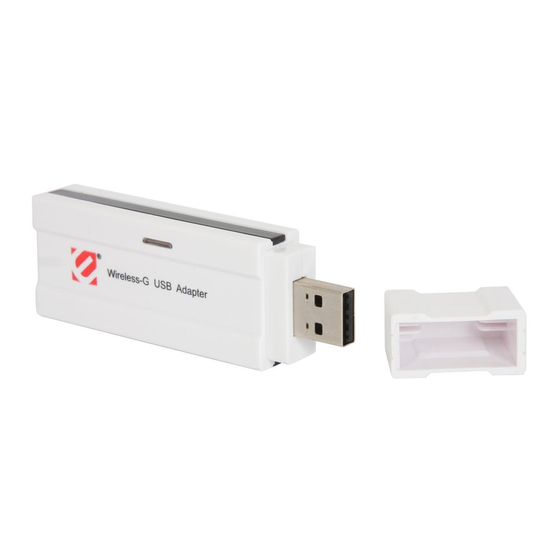Table of Contents
Advertisement
Quick Links
Download this manual
See also:
User Manual
Advertisement
Table of Contents

Summary of Contents for Encore ENUWI-G2
- Page 1 ENUWI-G2 802.11g Wireless USB 2.0 Adapter User’s Guide...
-
Page 2: Table Of Contents
TABLE OF CONTENT Introduction ... 1 Overview of this User’s Guide ... 1 Unpacking and Setup... 2 Unpacking... 2 Setup ... 2 Hardware Installation ... 3 LED Indicator ... 3 Check the installation ... 3 Software Installation... 4 Utility and Driver Installation... 4 Wireless utility setting ... -
Page 3: Introduction
INTRODUCTION Congratulations on your purchase of ENCORE 802.11g Wireless USB 2.0 Adapter. This manual helps to get familiar with ENCORE 802.11g Wireless USB 2.0 Adapter. This manual contains detailed instructions in operation of this product. Please keep this manual for future reference. With a Wireless LAN (IEEE 802.11g) USB 2.0 Adapter, a desktop or laptop computer can communicate with another computer in a wireless way. -
Page 4: Unpacking And Setup
UNPACKING AND SETUP This chapter provides unpacking and setup information for ENCORE 802.11g Wireless USB 2.0 Adapter. Unpacking Open the box of ENCORE 802.11g Wireless USB 2.0 Adapter and carefully unpack it. The box should contain the following items: One 802.11g Wireless USB 2.0 Adapter One Driver &... -
Page 5: Hardware Installation
HARDWARE INSTALLATION LED Indicator LINK The LINK LED lights green when ENCORE 802.11g Wireless USB 2.0 Adapter is connected to a network successfully. Otherwise the LINK indicator blinks green while the 802.11g Wireless USB 2.0 Adapter is access the wireless network. Check the installation The LED of ENCORE 802.11g Wireless USB 2.0 Adapter is clearly visible and the status of the network link can be seen instantly:... -
Page 6: Software Installation
SOFTWARE INSTALLATION This section will lead you to install the driver and utility of the 802.11g Wireless USB 2.0 Adapter. There are 2 ways to install the adapters: 1. Utility and Driver Installation using Adapter Setup Wizard (for Windows XP/Vista only) Insert Encore 802.11g Wireless LAN Adapter Driver &... - Page 7 2. Click “Finish” to finish the installation.
- Page 8 3. Plug-in your 802.11g Wireless USB 2.0 Adapter into your computer’s USB port. 4. When start the utility first time, you will see the Wireless Configuration Utility Country Selector, select the country domain where you are using this Wireless device, users are responsible for ensuring that the region domain configuration is in compliance with the regulatory standards of these countries.
-
Page 9: Wireless Utility Setting
WIRELESS UTILITY SETTING Windows® XP users may use the built-in wireless utility as default. The following instructions are for Service Pack 2 users. If you are using Windows® 2000/98/ME, you must use the Wireless Utility. With the Wireless utility, users can configure all the functions provided by the Wireless LAN Adapter Utility. -
Page 10: Configuration
Configuration This is the page where you can change the basic settings of the 802.11g Wireless USB 2.0 Adapter with the minimum amount of effort to implement a secure wireless network environment. SSID: The SSID differentiates one Wireless LAN group name from another; so all access points and all devices attempting to connect to a specific Wireless LAN group name must use the same SSID. -
Page 11: Advanced
Preamble: Select Long or Short/Long (auto) Preamble type. Preamble is a sequence of bits transmitted at 1Mbps that allows the PHY circuitry to reach steady-state demodulation and synchronization of bit clock and frame start. Two different preambles and headers are defined: the mandatory supported Long Preamble and header, which interoperates with the 1 Mbit/s and 2 Mbit/s DSSS specification (as described in IEEE Std. - Page 12 Shared Key/Open System Network Key: Choose the encryption way, either in HEX or ASCII formats, and enter the password in the blank space. Key Length, Key Format and WEP Key: If you select 64bit in Hex format, you must type 10 values in the following range (0~F, hexadecimal), or 64bit in ASCII format, you must type 5 values in the following range (0~9, A~Z and a~z Alphanumeric).
- Page 13 WPA / WPA2 WPA2 (Wi-Fi Protected Access 2) is the second generation of WPA; providing enterprise and consumer Wi-Fi user with a high level of assurance that only authorized user can access their wireless networks. WPA2 is based on the final IEEE802.11i amendment to the 802.11 standard and is eligible for FIPS 140-2 compliant.
-
Page 14: Site Survey
Site Survey Available Network The screen shows all the Wireless LAN devices around your Wireless LAN USB Adapter. The information of the wireless devices includes the SSID, MAC Address, Channels, Signal, the Security type and the Network mode. You can click the “Refresh” button to find the new wireless LAN devices, and double-click the device to choose the wireless station that you want to connect with. - Page 15 Profile Add: Click “Add” to create a new profile, set the related values such as Profile name, SSID, Wireless Mode and Security settings than click ”Apply” to save the profile. Edit: Click “Edit” to modify existing profile, modify the settings than click ”Apply”...
-
Page 16: Technical Specifications
TECHNICAL SPECIFICATIONS Standards Radio Technology Data Transfer Rate Receiver Sensitivity Frequency Range Modulation Schemes Channels Media Access Protocol CSMA/CA with ACK Security Diagnostic LED Antenna Driver Support Continuous Current Consumption Temperature Humidity Dimensions Certifications General IEEE 802.11g, USB 2.0, 1.1, 1.0 IEEE 802.11b -- DSSS IEEE 802.11g -- OFDM 1, 2, 5.5, 6, 9, 11, 12, 18, 24, 36, 48, 54Mbps (auto sense)












Need help?
Do you have a question about the ENUWI-G2 and is the answer not in the manual?
Questions and answers